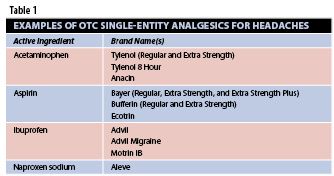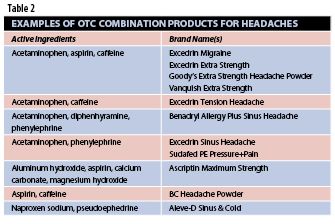Publication
Article
Pharmacy Times
Stopping Headache Pain
Author(s):
There are more OTC analgesics that there are types of headaches, and patients need help making a safe and effective choice.
There are more OTC analgesics that there are types of headaches, and patients need help making a safe and effective choice.
Pharmacists are likely to encounter patients seeking guidance on OTC medications for the management and treatment of headaches. Statistically, an estimated 33% of nonprescription analgesic use is for headaches.1
Types of Headaches
Headaches are commonly categorized as primary or secondary. Primary headaches account for approximately 90% of headaches and are not related to an underlying illness.2 Examples of primary headaches include tension headaches, cluster headaches, migraines, and medication overuse headaches (also known as rebound headaches). 1-5
Tension Headaches
Tension headaches, also referred to as stress headaches, are experienced by an estimated 75% of individuals in the United States and are considered to be more prevalent in women than in men.2,6 These types of headaches are characterized by mild pain that gradually starts at the back of the head and upper neck. The pain is usually bilateral, and is often described as a tight, pressing, constricting pain.1-3 Tension headaches may last from minutes to days.1-3 Stress, anxiety, fatigue, eyestrain, and muscular tension are common causes of tension headaches.1,6 Tension headaches may be episodic or chronic. Those patients experiencing frequent or chronic tension headaches should be referred to a physician for further medical treatment.5
Migraine Headaches
Migraine headaches affect an estimated 18% of women and 6% of men, or approximately 12% of the total US population. 1,7 An estimated 4% to 10% of children experience migraine headaches.8 The incidence of migraine headaches is equal among prepubescent boys and girls; incidence typically disappears in boys after puberty.1 Migraine headaches can occur with or without aura. Migraine sufferers usually have their first attack before age 30.1 Migraines are most common between 15 and 55 years of age.9 An estimated 70% to 80% of those who experience migraines also have a family member with a history of migraines.8,9
Some women have premenstrual migraine attacks or experience migraines at other times before, during, and after the menstrual cycle.1 The pain associated with migraine headaches is typically unilateral, and is often described as intense and throbbing.1-3 The pain may be preceded by an aura and onset may be sudden. Some patients experience sensitivity to light, noise, or odors, as well as nausea and vomiting.1-4 Migraine headaches may last from a few hours to 72 hours.4 Examples of factors that may trigger a migraine headache include stress; fatigue; anxiety; fasting or missing meals; changes in weather, altitude, or air pressure; hormonal changes, such as during menstrual cycle or pregnancy; environmental factors, such as noise, bright lights, or certain odors; vasoactive substances in certain foods; alcohol consumption; use of certain pharmacologic agents (eg, nitrates, oral contraceptives, nifedipine, postmenopausal hormones); and changes in sleeping or eating patterns.1,10


Cluster Headaches
Cluster headaches are the least commonly occurring of primary headaches, affecting 1% of the population.4 Cluster headaches are more prevalent among men, who account for 85% to 90% of individuals experiencing these types of headaches.4,7 Cluster headaches are often accompanied by severe pain that is throbbing and constant and is typically unilateral, occurring around or behind 1 eye. The affected eye may become red, inflamed, and watery.1-4 Patients may also experience nasal congestion, rhinitis, and sweating.4 These headaches may last from 15 to 180 minutes.4 Cluster headaches can occur daily in periods of weeks or months. Individuals suspected of having cluster headaches should be encouraged to seek medical care from their primary health care provider.4,7

Secondary Headaches
A headache is classified as a secondary headache when it is the result of another underlying medical condition, including sinusitis, severe hypertension, head trauma, hematomas, temporomandibular joint dysfunction, metabolic disorders, cerebral hemorrhage, and meningitis.7,11,12 Patients experiencing secondary headaches should be referred for further medical evaluation and treatment.
OTC Therapies
According to the American Headache Society, many people elect to use OTC analgesics to manage and treat headaches because they are easy to obtain and use and the cost is lower when compared with prescription medications.13 According to the Handbook of Nonprescription Drugs, the types of headaches that are most often amenable to self-treatment with the use of OTC analgesics include tension headaches, diagnosed migraines, and sinus headaches.1
Nonprescription analgesic options include acetaminophen, nonsteroidal antiinflammatory drugs (ibuprofen, naproxen), and salicylates (aspirin, magnesium salicylate, sodium salicylate). These products are available as single-entity or combination products in a variety of forms, such as tablets, capsules, gel capsules, liquigels, enteric-coated, extended- or sustainedrelease formulations, liquids, suspensions, effervescent tablets, rapid-release gel capsules, powders, and chewable tablets.
The Role of the Pharmacist
Prior to recommending any of these products, pharmacists should screen for possible allergies, drug interactions, and contraindications, which can include renal and hepatic insufficiencies, history of gastric ulcers, or use of anticoagulants. Refer patients for further medical evaluation when warranted. Patients should be reminded about the proper use, recommended duration of use, and potential adverse effects associated with the use of these products. Encourage patients to seek further medical care if they do not obtain any relief from the use of these products, experience chronic headaches, or have headaches that increase in intensity or frequency. Patients should also be reminded that excessive use of these products may lead to rebound headaches or medication overuse headaches. Nonpharmacologic measures that may be beneficial in alleviating or preventing headaches include relaxation techniques, avoiding stress, and getting an adequate amount of sleep.
Ms. Terrie is a clinical pharmacy writer based in Haymarket, Virginia.
References
1. Remington T. Headache. In: Berardi R, Newton G, McDermott JH, et al, eds. Handbook of Nonprescription Drugs. 16th ed. Washington, DC: American Pharmacists Association; 2009:65-81.
2. Headaches. American College of Physicians Web site. www.acponline.org/patients_families/diseases_conditions/headaches/. Accessed January 26, 2011.
3. Types of headaches and causes. Excedrin Web site. www.excedrin.com/headache-types-and-causes.shtml. Accessed January 26, 2011.
4. Types of headaches. American Headache Society Web site. www.achenet.org/education/patients/typesofheadaches.asp. Accessed January 26, 2011.
5. Tension type headaches. National Headache Foundation Web site. www.headaches.org/education/Headache_Topic_Sheets/Tension-Type_Headache. Accessed January 26, 2011.
6. Headache: tension type. Ferri’s Clinical Advisor 2011. MD Consult Web site. www.mdconsult.com/books/page.do?eid=4-u1.0-B978-0-323-05610-6..00001-9&isbn=978-0-323-05610-6&type=bookPage§ionEid=4-u1.0-B978-0-323-05610-6..00001-9&uniqId=234335460-4#4-u1.0-B978-0-323-05610-6..00001-9. Accessed January 26, 2011.
7. Headache: Hope through research. National Institute of Neurological Disorders and Stroke Web site. www.ninds.nih.gov/disorders/headache/detail_headache.htm. Accessed January 27, 2011.
8. Headaches in children. American Headache Society Web site. www.achenet.org/education/patients/HeadachesinChildren.asp.
9. Understanding migraines. Excedrin Web site. www.excedrin.com/understanding-migraines.shtml. Accessed January 26, 2011.
10. Migraine. Medline Plus Web site. www.nlm.nih.gov/medlineplus/ency/article/000709.htm. Accessed January 26, 2011.
11. Secondary Headaches. American Headache Society Web site. www.achenet.org/education/patients/SecondaryHeadaches.asp. Accessed January 27, 2011.
12. Headaches. Merck Manual Web site. www.merck.com/mmpe/sec16/ch216/ch216a.html#CACCDJAH.
13. Acute Therapy: Why not over the counter or other nonspecific options? American Headache Society Web site.
www.achenet.org/education/patients/AcuteTherapyWhyNotOvertheCounterorOtherNonspecificOptions.asp. Accessed January 27, 2011.
14. Important information about Nonsteroidal Anti-Inflammatory Drugs (NSAIDs). McNeil Consumer Health Motrin Web site. www.motrin.com/page.jhtml?id=/motrin/include/3_1.inc. Accessed January 27, 2011.







